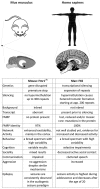Of Men and Mice: Modeling the Fragile X Syndrome
- PMID: 29599705
- PMCID: PMC5862809
- DOI: 10.3389/fnmol.2018.00041
Of Men and Mice: Modeling the Fragile X Syndrome
Abstract
The Fragile X Syndrome (FXS) is one of the most common forms of inherited intellectual disability in all human societies. Caused by the transcriptional silencing of a single gene, the fragile x mental retardation gene FMR1, FXS is characterized by a variety of symptoms, which range from mental disabilities to autism and epilepsy. More than 20 years ago, a first animal model was described, the Fmr1 knock-out mouse. Several other models have been developed since then, including conditional knock-out mice, knock-out rats, a zebrafish and a drosophila model. Using these model systems, various targets for potential pharmaceutical treatments have been identified and many treatments have been shown to be efficient in preclinical studies. However, all attempts to turn these findings into a therapy for patients have failed thus far. In this review, I will discuss underlying difficulties and address potential alternatives for our future research.
Keywords: E/I balance; FMR1; Fragile X Syndrome; autism spectrum disorders; behavior and cognition; microsatellite instability; mouse model; primates.
Figures



Similar articles
-
Audiogenic Seizures in the Fmr1 Knock-Out Mouse Are Induced by Fmr1 Deletion in Subcortical, VGlut2-Expressing Excitatory Neurons and Require Deletion in the Inferior Colliculus.J Neurosci. 2019 Dec 4;39(49):9852-9863. doi: 10.1523/JNEUROSCI.0886-19.2019. Epub 2019 Oct 30. J Neurosci. 2019. PMID: 31666356 Free PMC article.
-
Modeling Fragile X Syndrome in Drosophila.Front Mol Neurosci. 2018 Apr 16;11:124. doi: 10.3389/fnmol.2018.00124. eCollection 2018. Front Mol Neurosci. 2018. PMID: 29713264 Free PMC article. Review.
-
Modeling fragile X syndrome in the Fmr1 knockout mouse.Intractable Rare Dis Res. 2014 Nov;3(4):118-33. doi: 10.5582/irdr.2014.01024. Intractable Rare Dis Res. 2014. PMID: 25606362 Free PMC article. Review.
-
Inhibition of GluN2A NMDA receptors ameliorates synaptic plasticity deficits in the Fmr1-/y mouse model.J Physiol. 2018 Oct;596(20):5017-5031. doi: 10.1113/JP276304. Epub 2018 Sep 19. J Physiol. 2018. PMID: 30132892 Free PMC article.
-
Epigenetic characterization of the FMR1 gene and aberrant neurodevelopment in human induced pluripotent stem cell models of fragile X syndrome.PLoS One. 2011;6(10):e26203. doi: 10.1371/journal.pone.0026203. Epub 2011 Oct 12. PLoS One. 2011. PMID: 22022567 Free PMC article.
Cited by
-
Opportunities and limitations of genetically modified nonhuman primate models for neuroscience research.Proc Natl Acad Sci U S A. 2020 Sep 29;117(39):24022-24031. doi: 10.1073/pnas.2006515117. Epub 2020 Aug 19. Proc Natl Acad Sci U S A. 2020. PMID: 32817435 Free PMC article. Review.
-
Across Dimensions: Developing 2D and 3D Human iPSC-Based Models of Fragile X Syndrome.Cells. 2022 May 24;11(11):1725. doi: 10.3390/cells11111725. Cells. 2022. PMID: 35681419 Free PMC article. Review.
-
Sex Differences in Brain Disorders.Int J Mol Sci. 2023 Sep 26;24(19):14571. doi: 10.3390/ijms241914571. Int J Mol Sci. 2023. PMID: 37834018 Free PMC article. Review.
-
Molecular Biomarkers in Fragile X Syndrome.Brain Sci. 2019 Apr 27;9(5):96. doi: 10.3390/brainsci9050096. Brain Sci. 2019. PMID: 31035599 Free PMC article. Review.
-
Connecting DCX, COMT and FMR1 in social behavior and cognitive impairment.Behav Brain Funct. 2022 May 19;18(1):7. doi: 10.1186/s12993-022-00191-7. Behav Brain Funct. 2022. PMID: 35590332 Free PMC article.
References
-
- Ackerman S. (1992). Discovering the Brain. Washington, DC: National Academies Press. - PubMed
-
- Adihe Lokanga R., Zhao X.-N., Entezam A., Usdin K. (2014). X inactivation plays a major role in the gender bias in somatic expansion in a mouse model of the fragile X-related disorders: implications for the mechanism of repeat expansion. Hum. Mol. Genet. 23, 4985–4994. 10.1093/hmg/ddu213 - DOI - PMC - PubMed
Grants and funding
LinkOut - more resources
Full Text Sources
Other Literature Sources
Molecular Biology Databases

